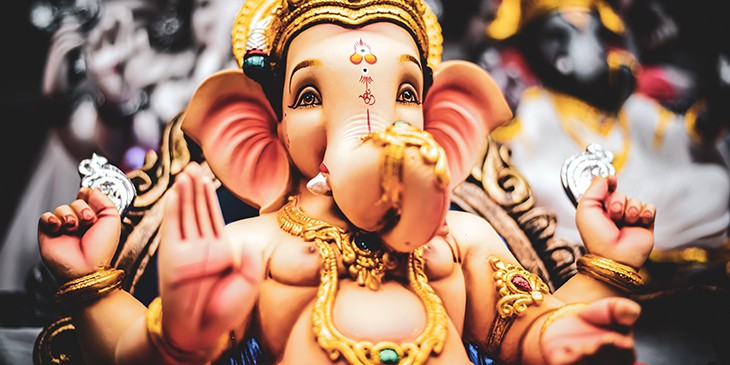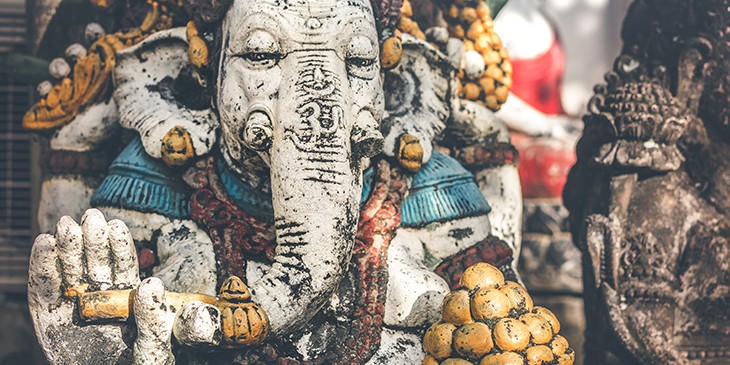Table of contents

If you are interested in non-traditional religions of the Eastern world, you have probably heard of or seen an image of Ganesha. Represented by a person sitting cross-legged in a peculiar way, with the head of an elephant and with 4 arms, Lord Ganesha is the God of wisdom and fortune for Hinduism.
But people don't worship him just because he is related to intellect and abundance. God Ganesha is one of the most important gods in Hindu culture, considered the "Destroyer of Obstacles".
But who is Ganesha? To answer this question, check out the fascinating history of this God, his representations and meanings. In addition, we will translate all the symbols of his image so that you understand his importance.
- Learn about some protective symbols and their meanings
Who is Ganesha?
Known as the "Destroyer of Obstacles" (Vinayaka in Hinduism), Lord Ganesha is considered to be the ultimate symbol of intellect, logical awareness, and fortune. Therefore, he is represented by the God of wisdom, according to Hindu tradition.
Thus, Ganesha is a very important God of this culture for being the first son of Shiva (supreme God, "Destroyer and Regenerator") and Parvati (mother God). With the influence of these two powerful representations of Hinduism, Lord Ganesha is the one who opens the paths with logical and intelligent solutions.
Traditionally, his followers were businessmen and merchants, because Ganesha symbolizes good fortune and success, with his intelligence to find rational solutions to financial problems.
However, today God Ganesha is also respected by people who have difficulties and need divine guidance. This is because of his power to remove obstacles with his knowledge and education.
See_also: Cartomancy - Letters of the Suit of CupsGanesha Mantra
Ganesha's mantra is one of the most popular in Hindu culture because it symbolizes Om ("primordial sound"). In the Tamil language (spoken in southern India), the syllable Om is considered sacred and represents the head of the God Ganesha.
That is why Ganesha's mantra is one of the most used by people seeking to attract prosperity and the removal of obstacles, both material and spiritual. In other words, if you find yourself blocked in a problem, count on Ganesha's wisdom to find a way out.
Check out Ganesha's mantra and its translation:
Om Gam Ganapataye Namah
I salute You, Lord of the troops
- Om: the primordial invocation, connects the devotee and God Ganesha;
- Gam: means to go, to move, to move away, to come, to draw near, to join;
- Ganapati: symbolizes Ganesha, Gana (troop) and Pati (lord);
- Namah: Namas is worship.
Are you interested in Ganesha's mantra? Then watch the video below and practice it with a good meditation:
Ganesha Chakra
Lord Ganesha resides in the first chakra, the Muladhara, because he is the God of letters, intelligence, learning, and fortune. In this chakra, the divine force is found, that is, Ganesha resides in each person.
Located toward the base of the spine, Ganesha's chakra is what keeps us grounded and in touch with the spiritual world, and governs the powerful forces that stimulate our lives.
Learn how to harmonize your chakras for a more balanced life, aligned with your vital energies.
The image of Ganesha translated

In both the Eastern and Western world, it is possible to find the image of Ganesha in any faith space. This is because every detail of his image has a mystical symbol that represents Ganesha's power.
So, according to the Hindu religion, find out the image of Ganesha and its meanings below.
See_also: Learn about the Moon's phases in 2022Check out other sacred tools of the Hindu religion:
- What is Japamala? Learn all about this sacred necklace!
- What is Mandala? See the meaning and learn how to use it in meditation in 6 steps
- What are Mudras? Learn these gestures and increase the benefits of your Yoga practice
The Head
Ganesha's head is represented by an elephant, indicating intelligence, fidelity, and his discriminating power. His single tusk symbolizes his ability to overcome the dualisms of life.
His wide open ears signify his ability to listen when people seek spiritual guidance, so they are considered the symbol of wisdom, because one must know how to listen in order to help with Ganesha's knowledge.
Ganesha's intellect is symbolized by his curved trunk, manifesting his power to discriminate what is real or not. On his forehead, the trident trishula (Shiva's weapon) is drawn to show Ganesha's superiority over time (past, present and future).
The Belly
Ganesha's belly is large to carry the "infinite universes", both the bounty of nature and tranquility of spirit. In addition, his belly serves to absorb the sufferings of the universe and protect beings and the world.
The legs
In his image, Ganesha has one leg bent, as if resting, and the other standing, always alert. The symbol of his legs shows the need to maintain a participative experience in the material and spiritual worlds.
The arms
Ganesha has four arms, and each represents the qualities of the subtle body:
- Manas: the mind;
- Budhi: the intellect;
- Ahamkara: the ego;
- Chitta: the conditioned consciousness.
Lord Ganesha, on the other hand, represents Atman (pure consciousness), allowing the proper functioning of the four attributes in human beings.
Hands
Ganesha's first hand holds a hatchet to destroy the obstacles that are imposed by desire and that result in pain and suffering. Moreover, the hatchet leads us in search of the truth.
His second hand holds a whip as the force that leads people toward the faith of God, forgetting worldly attachments and desires. The third hand is in a pose of blessings and protection, indicating the devotee.
Finally, Ganesha's fourth hand is holding the lotus flower (padma) that signifies the realization of his true self, as the main goal of human evolution.
Ganesha and the Mouse
Ganesha's image is mounted on a mouse (Mushika), representing his divine vehicle. Thus, the mouse symbolizes detailed investigation to solve a difficult problem. In other words, the symbol represents Ganesha's knowledge and cunning.
Lord Ganesha's vehicle teaches that people should always be alert and alert to illuminate the inner self with the light of wisdom. However, another interpretation states that the rat reflects the ego, desires, and pride of individuality. By riding the rat, Ganesha becomes the master of these tendencies with the power to control them.
The God Ganesha is an important figure in Hindu culture with his power to open paths, attract prosperity, and bring wisdom to afflicted minds.


